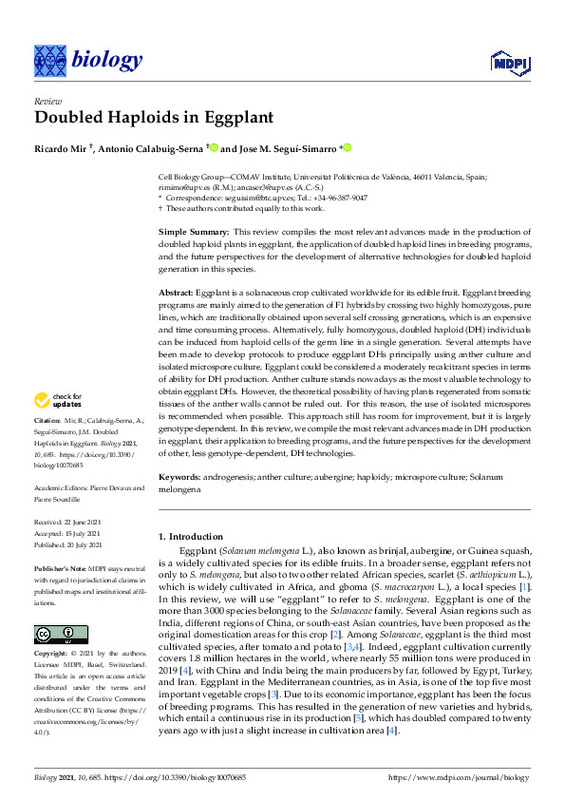JavaScript is disabled for your browser. Some features of this site may not work without it.
Buscar en RiuNet
Listar
Mi cuenta
Estadísticas
Ayuda RiuNet
Admin. UPV
Doubled haploids in eggplant
Mostrar el registro sencillo del ítem
Ficheros en el ítem
| dc.contributor.author | Mir Moreno, Ricardo
|
es_ES |
| dc.contributor.author | Calabuig-Serna, Antonio
|
es_ES |
| dc.contributor.author | Seguí-Simarro, Jose M.
|
es_ES |
| dc.date.accessioned | 2022-04-28T18:04:53Z | |
| dc.date.available | 2022-04-28T18:04:53Z | |
| dc.date.issued | 2021-07 | es_ES |
| dc.identifier.uri | http://hdl.handle.net/10251/182269 | |
| dc.description.abstract | [EN] This review compiles the most relevant advances made in the production of doubled haploid plants in eggplant, the application of doubled haploid lines in breeding programs, and the future perspectives for the development of alternative technologies for doubled haploid generation in this species. Eggplant is a solanaceous crop cultivated worldwide for its edible fruit. Eggplant breeding programs are mainly aimed to the generation of F1 hybrids by crossing two highly homozygous, pure lines, which are traditionally obtained upon several self crossing generations, which is an expensive and time consuming process. Alternatively, fully homozygous, doubled haploid (DH) individuals can be induced from haploid cells of the germ line in a single generation. Several attempts have been made to develop protocols to produce eggplant DHs principally using anther culture and isolated microspore culture. Eggplant could be considered a moderately recalcitrant species in terms of ability for DH production. Anther culture stands nowadays as the most valuable technology to obtain eggplant DHs. However, the theoretical possibility of having plants regenerated from somatic tissues of the anther walls cannot be ruled out. For this reason, the use of isolated microspores is recommended when possible. This approach still has room for improvement, but it is largely genotype-dependent. In this review, we compile the most relevant advances made in DH production in eggplant, their application to breeding programs, and the future perspectives for the development of other, less genotype-dependent, DH technologies. | es_ES |
| dc.description.sponsorship | This research was funded by the Valencian Government, grant number CDEIGENT 2018/023 to RMM and by the Spanish MICINN, grant number PID2020-115763RB-I00 to JMSS. ACS is the recipient of a predoctoral contract from the FPU program of the Spanish Government. | es_ES |
| dc.language | Inglés | es_ES |
| dc.publisher | MDPI AG | es_ES |
| dc.relation.ispartof | Biology | es_ES |
| dc.rights | Reconocimiento (by) | es_ES |
| dc.subject | Androgenesis | es_ES |
| dc.subject | Anther culture | es_ES |
| dc.subject | Aubergine | es_ES |
| dc.subject | Haploidy | es_ES |
| dc.subject | Microspore culture | es_ES |
| dc.subject | Solanum melongena | es_ES |
| dc.subject.classification | GENETICA | es_ES |
| dc.subject.classification | BIOLOGIA CELULAR | es_ES |
| dc.subject.classification | BIOQUIMICA Y BIOLOGIA MOLECULAR | es_ES |
| dc.title | Doubled haploids in eggplant | es_ES |
| dc.type | Artículo | es_ES |
| dc.identifier.doi | 10.3390/biology10070685 | es_ES |
| dc.relation.projectID | info:eu-repo/grantAgreement/AEI/Plan Estatal de Investigación Científica y Técnica y de Innovación 2017-2020/PID2020-115763RB-I00/ES/ESTUDIO DEL PAPEL DEL CALCIO EN LA INDUCCION DE EMBRIOGENESIS IN VITRO EN ESPECIES VEGETALES MODELO Y RECALCITRANTES/ | es_ES |
| dc.relation.projectID | info:eu-repo/grantAgreement/GENERALITAT VALENCIANA//CDEIGENT%2F2018%2F023//ESTUDIO Y APLICACIONES BIOTECNOLOGICAS DE LA TOTIPOTENCIA DE LAS CELULAS VEGETALES/ | es_ES |
| dc.rights.accessRights | Abierto | es_ES |
| dc.contributor.affiliation | Universitat Politècnica de València. Instituto Universitario de Conservación y Mejora de la Agrodiversidad Valenciana - Institut Universitari de Conservació i Millora de l'Agrodiversitat Valenciana | es_ES |
| dc.contributor.affiliation | Universitat Politècnica de València. Departamento de Biotecnología - Departament de Biotecnologia | es_ES |
| dc.description.bibliographicCitation | Mir Moreno, R.; Calabuig-Serna, A.; Seguí-Simarro, JM. (2021). Doubled haploids in eggplant. Biology. 10(7):1-16. https://doi.org/10.3390/biology10070685 | es_ES |
| dc.description.accrualMethod | S | es_ES |
| dc.relation.publisherversion | https://doi.org/10.3390/biology10070685 | es_ES |
| dc.description.upvformatpinicio | 1 | es_ES |
| dc.description.upvformatpfin | 16 | es_ES |
| dc.type.version | info:eu-repo/semantics/publishedVersion | es_ES |
| dc.description.volume | 10 | es_ES |
| dc.description.issue | 7 | es_ES |
| dc.identifier.eissn | 2079-7737 | es_ES |
| dc.identifier.pmid | 34356540 | es_ES |
| dc.identifier.pmcid | PMC8301345 | es_ES |
| dc.relation.pasarela | S\443144 | es_ES |
| dc.contributor.funder | GENERALITAT VALENCIANA | es_ES |
| dc.contributor.funder | AGENCIA ESTATAL DE INVESTIGACION | es_ES |
| dc.contributor.funder | Ministerio de Ciencia e Innovación | es_ES |
| upv.costeAPC | 2057 | es_ES |








